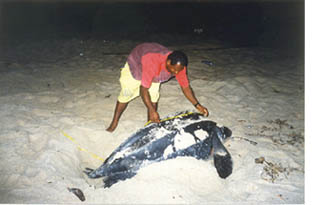
Measuring Biodiversity
From the definition alone, which is very broad, it is clear that
no single measure of biodiversity will be adequate. Biodiversity
can not be captured in a single number. Essentially, measurements
have two components:
• The number of entities e.g. the number of individuals, the
number of species, the number of different habitats etc.
• The degree of difference (dissimilarity) between those entities.
Species richness (the number of species) describes the number of
elements but will not capture information on the number of individuals
of the species. Rarity and conservation status, dependant on how
threatened a species is, can also provide a measure of biodiversity.
Measures of biodiversity are commonly used as the basis for making
conservation decisions or for planning more generally. Different
measures of biodiversity may support different solutions. Often
indicator species are used as a way of measuring biodiversity. Using
this method can be very useful but it introduces an aspect of how
we value different components of biodiversity. For example, we are
more likely to use the abundance of birds or butterflies on a farm
as a measure of biodiversity than the richness of microbes in the
soil.
Genetic diversity can be measured directly by looking at genes
and chromosomes or indirectly by looking at physical features of
the organisms and assuming they have a genetic basis. Using the
genetic code is arguably the strongest method of measuring biodiversity
as it is looking at the building blocks of life.
Generally, multicellular organisms tend to have more DNA than single-celled
organisms but there are exceptions. Similarly, although there appears
to be an overall trend of increasing amount of DNA with increasing
complexity of organisms, this is not invariant. The species with
the greatest amount of DNA has about 100,000 times as much as that
with the least, but the species with the largest number of genes
has only 20 times as many genes as that found in many bacteria.
In other words, much genetic variation is attributable not to differences
in the number of functional genes, but in the amounts of non-coding
DNA. One of the most striking findings is that there are many ‘universal’
gene segments in a wide range of organisms suggesting the existence
of an ancient minimal set of DNA sequences that all cells must have.
Whilst biodiversity can be measured in a host of ways, in practice
it tends to be measured in terms of species richness; the number
of species.
The advantages of this are:
• Practical application: Species richness has proven to be
measurable in practice, at least to the point where different workers
will provide similar estimates of species numbers.
• Existing information: A substantial amount of information
already exists on patterns in species richness, and this has been
made available in scientific literature.
• Surrogacy: Species richness acts as a surrogate measure
for many other kinds of variation in biodiversity. In general, as
long as the numbers involved are at least moderate, greater numbers
of species tend to embody more genetic diversity (in the form of
a greater diversity of genes through to populations), more species
diversity, and greater ecological diversity.
• Wide application: The species unit is commonly seen as the
unit of practical management, of legislation and of political discourse.
For a wide range of people, variation in biodiversity is pictured
as variation in species richness.
The disadvantages are:
• Definition of species: The lack of agreement as to what
constitutes a species. In major part this results because species
can, to a large extent be regarded as hypotheses, opinions or concepts,
as much as real robust entities. Click
here to see the different definitions of species. The vast majority
of groups of organisms have been, and are still being, described
based on collections of preserved specimens using differences in
morphological characteristics. Fortunately, this method of defining
a species continues to be relatively effective for most multicelluar
species. It is not an adequate method of defining single cell organisms.
• Different kinds of diversity: An additional limitation of
species richness as a measure of biodiversity has frequently been
illustrated with reference to the issue of whether an assemblage
of a small number of closely related species, say two species of
mouse, is more or less biodiverse than an equivalent sized assemblage
of more distantly related species, say a species of mouse and a
species of shrimp.
Photo Credit: Sammy, Leatherback Turtle
|




